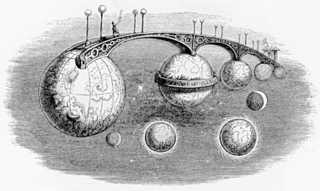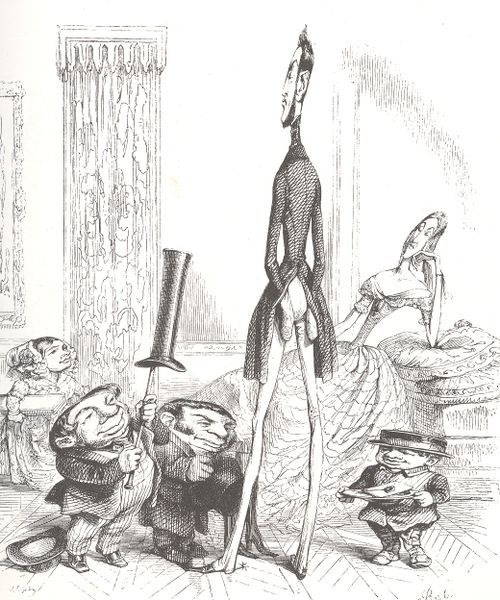JF Ptak Science Books LLC Post 705 Blog Bookstore
Finding the Big Bang in a bowl of soapy water.
Last year I wrote a little aboutJ.J.Grandville’s interplanetary bridge connecting some of the planets (and including a balcony constructed of Saturn’s ring [sic] in an early Victorian Grad Tour solar system walkabout. Grandville (the pseudonym of Jean Ignace Isidore Gérard, born in 1803 and staggering too quickly out of life in 1847) was an extraordinary talent working somewhat out and ahead of his time; he had superb visions of the future, and of the past, and most of them were fantastic and fanciful, though not without some very stinging social commentary. He has been called a proto-Surrealist and I’d have to agree, though for me he had a larger production of social commentary in his work than any of the “real” Surrealists of the 20th century. For example, in his Un Autre Monde ("Another World") he depicts people’s social stature literally—the taller and thinner, the more socially important; the shorter and stouter, the more disposable/replaceable; the images are funny, convincing and wincingly penetrative.
This being said, I have a special interest in the astronomically-based images that he produced, and so far as I can tell, there weren’t many of them in his vast output. In chapter 25 (“The Mysteries of Infinity”) of Un Autre Monde Grandville rolls out the great maker of the universe, the Primum Mobile, the Motive Force, the First Mover. The old scamp was busy and on display for Grandville’s character Hahbble, who floats around in the cosmos, and comes face-to-face with what in the end is Einstein’s dice thrower, as much as the great physicist didn’t want him to be, nor is he subtle (Raffiniert ist der Herr Gott, aber boshaft ist er nicht!) The malicious (“boshaft”) part would be supplied by someone else looking intent and dangerous, while the great maker turns out to be a magician who is happily creating the matter of all stuff by making it all out of bubbles.
(I feel relatively certain that Grandville is the first artist to propose the bubble theory of cosmology, and he is among a select and restrictive minority who allocated such a seemingly meaningless activity with the creation of creation. I like its playful nature, though I wonder if his approach was seen as a deep mockery and perhaps heretically insulting to the religco-forces that helped and plagued the 19th century. Mostly it seems he was left behind int he appreciation part of acknowledgment, glory faded before his eyes; his work wasn’t necessarily prized during his lifetime, and he had his share of brutal reviews for his great adventures. Paul St. Victor, art critic, wrote that Grandville “wanted to dance on the clouds in leaden shoes”and “tried to get to heaven on a bus”. That’s a tough go. Death did bring him some fame as M. Grandville slept with the worms; publishers used his illustrations mostly without gratuity to any estate, the images showing up all over the place through the end of the 19th century. His cuts were used again and again,the blocks being progressively degrade until the fineness of Grandville's eye and incision were lost to overuse--it is easy to see the difference in crispness and clarity between the early printngs of his pictures with the later ones, his sharp edges getting rounded by greed and use and time.3)
I imagine this magician to be “almost” infinitely large and small (what does “almost” infinitely mean?) , blowing bubbles on a large galaxy scale, the bubbles containing other galaxies; or smaller yet, other solar systems; and smaller yet, other planets. And taking it down to the other extreme, he could be sub-atomic, blowing bubbles of existence and shaping the bumpies of quantum foam in spacetime, letting loose the primordial bits that would become molecules that would or would not rise from the unpretty Dirac sea, living just on the other side of measureable in space and time, shaving barely-measureable slivers away from Planck length1 and Planck time2. Or maybe the old man is putting the white into Schwarzchild wormholes.
Maybe he’s just blowing the bubbles of possibility and chance, and his unacknowledged accomplice is injecting the mote in god’s eye.
Notes:
1. The Planck length 1.616 x 10 -35 (meters) which is the smallest measureable space in the universe (comprised of Planck’s constant, the gravitational constant and the speed of light) which in turn leads to
2. Planck
time, which is the amount of time it takes for light to traverse one Planck
length in a vacuum, 5.39 x 10 -44 seconds),
which is basically the smallest measureable unit of time, or for time that
would mean anything.
3. While ill with his own fatal bit, he composed
his own epitaph; Here Lies Grandville;
he loved everything, made everything live, speak and walk, but could not make a
way for himself”.
There’s actually quite a nice turn of phrase in the wiki article on Grandville—quite nice, really—which I include here: “Though the designs of Grandville are occasionally unnatural and absurd, they usually display keen analysis of character and marvelous inventive ingenuity, and his humour is always tempered and refined by delicacy of sentiment and a vein of sober thoughtfulness.” He evidently lived a hard-ish life, not the least of which were the deaths of his wife and two children in the early 1840’s.
Some of Grandville's other interesting works include:
Les petites miseres de la vie humaine (The Petty Sorrows of
Human Life) 1843
Un Autre Monde 1844
Cent Proverbes 1845
Jerome paturot 1846
Les Fleurs animees (The Personified Flowers) 1847






Comments